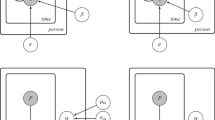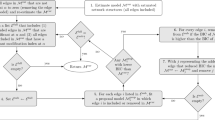Abstract
In the present paper a model for describing dynamic processes is constructed by combining the common Rasch model with the concept of structurally incomplete designs. This is accomplished by mapping each item on a collection of virtual items, one of which is assumed to be presented to the respondent dependent on the preceding responses and/or the feedback obtained. It is shown that, in the case of subject control, no unique conditional maximum likelihood (CML) estimates exist, whereas marginal maximum likelihood (MML) proves a suitable estimation procedure. A hierarchical family of dynamic models is presented, and it is shown how to test special cases against more general ones. Furthermore, it is shown that the model presented is a generalization of a class of mathematical learning models, known as Luce's beta-model.
Similar content being viewed by others
References
Andersen, E. B. (1973).Conditional inference and models for measuring. Unpublished dissertation, Mentalhygienisk Forskningsinstitut, Copenhagen.
Bock, R. D., & Aitkin, M. (1981). Marginal maximum likelihood estimation of item parameters: an application of an EM-algorithm.Psychometrika, 46, 443–459.
Bush, R. R., & Mosteller, F. (1951). A mathematical model for simple learning.Psychological Review, 58, 313–323.
de Leeuw, J., & Verhelst, N. D. (1986). Maximum likelihood estimation in generalized Rasch models.Journal of Educational Statistics, 11, 183–196.
Estes, W. K. (1972). Research and theory on the learning of probabilities.Journal of the American Statistical Association, 67, 81–102.
Ferguson, G. A. (1942). Item selection by the constant process.Psychometrika, 7, 19–29.
Fischer, G. H. (1972).A step towards dynamic test theory (Research Bulletin 24). Vienna: University of Vienna, Institute of Psychology.
Fischer, G. H. (1974).Einführung in die Theorie Psychologischer Tests [Introduction to the theory of psychological tests]. Bern: Huber.
Fischer, G. H. (1981). On the existence and uniqueness of maximum likelihood estimates in the Rasch model.Psychometrika, 46, 59–77.
Fischer, G. H. (1983). Logistic latent trait models with linear constraints.Psychometrika, 48, 3–26.
Follmann, D. (1988). Consistent estimation in the Rasch model based on nonparametric margins.Psychometrika, 53, 553–562.
Glas, C. A. W. (1988). The Rasch model and multi-stage testing.Journal of Educational Statistics, 13, 45–52.
Glas, C. A. W. (1989).Contributions to estimating and testing Rasch models. Arnhem: Cito.
Glas, C. A. W., & Verhelst, N. D. (1989). Extensions of the partial credit model.Psychometrika, 54, 635–659.
Jannarone, R. J. (1986). Conjunctive item response theory kernels.Psychometrika, 51, 357–373.
Kelderman, H. (1984). Loglinear Rasch model tests.Psychometrika, 49, 223–245.
Kempf, W. (1974). Dynamische Modelle zur Messung sozialer Verhaltenspositionen [Dynamic models for measuring social relationships]. In W. Kempf (Ed.),Probabilistische Modelle in de Sozialpsychologie [Probabilistic models in social psychology (pp. 13–55). Bern: Huber.
Kempf, W. (1977a). A dynamic test model and its use in the micro-evaluation of instrumental material. In H. Spada, W. Kempf, (Eds.),Structural models for thinking and learning (pp. 295–318). Bern: Huber.
Kempf, W. (1977b). Dynamic models for the measurement of ‘traits’ in social behavior. In W. Kempf, & B. H. Repp (Eds.),Mathematical models for social psychology (pp. 14–58). New York: Wiley.
Kiefer, J., & Wolfowitz, J. (1956). Consistency of the maximum likelihood estimator in the presence of infinitely many incidental parameters.Annals of Mathematical Statistics, 27, 887–903.
Laird, N. (1978). Nonparametric maximum likelihood estimation of a mixing distribution.Journal of the American Statistical Association, 73, 805–811.
Lawley, D. N. (1943). On problems connected with item selection and test construction.Proceedings of the Royal Society of Edinburgh, 61, 273–287.
Lord, F. M. (1952). A theory of test scores.Psychometric Monograph No. 7, 17(4, Pt. 2).
Louis, T. A. (1982). Finding the observed information matrix when using the EM algorithm.Journal of the Royal Statistical Society, Series B, 44, 226–233.
Luce, R. D. (1959).Individual choice behavior. New York: Wiley.
Luce, R. D., Bush, R. R., & Galanter, E. (Eds.). (1963).Handbook of mathematical psychology (3 volumes). New York: Wiley.
Mislevy, R. J. (1984). Estimating latent distributions.Psychometrika, 49, 359–381.
Neyman, J., & Scott, E. L. (1948). Consistent estimates, based on partially consistent observations.Econometrica, 16, 1–32.
Rasch, G. (1960).Probabilistic models for some intelligence and attainment tests. Copenhagen: Danish Institute for Educational Research.
Sternberg, S. H. (1959). A path dependent linear model. In R. R. Bush & W. K. Estes (Eds.),Studies in mathematical learning theory (pp. 308–339). Stanford: Stanford University Press.
Sternberg, S. H. (1963). Stochastic learning theory. In R. D. Luce, R. R. Bush, & E. Galanter (Eds.),Handbook of mathematical psychology, Vol. II (pp. 1–120). New York: Wiley.
Thissen, D. (1982). Marginal maximum likelihood estimation in the one-parameter logistic model.Psychometrika, 47, 175–186.
Verhelst, N. D., & Eggen, T. J. H. M. (1989).Psychometrische en statistische aspecten van peilingsonderzoek [Psychometric and statistical aspects of assessment research], PPON-rapport, 4. Arnhem: Cito.
Author information
Authors and Affiliations
Rights and permissions
About this article
Cite this article
Verhelst, N.D., Glas, C.A.W. A dynamic generalization of the Rasch model. Psychometrika 58, 395–415 (1993). https://doi.org/10.1007/BF02294648
Received:
Revised:
Issue Date:
DOI: https://doi.org/10.1007/BF02294648




